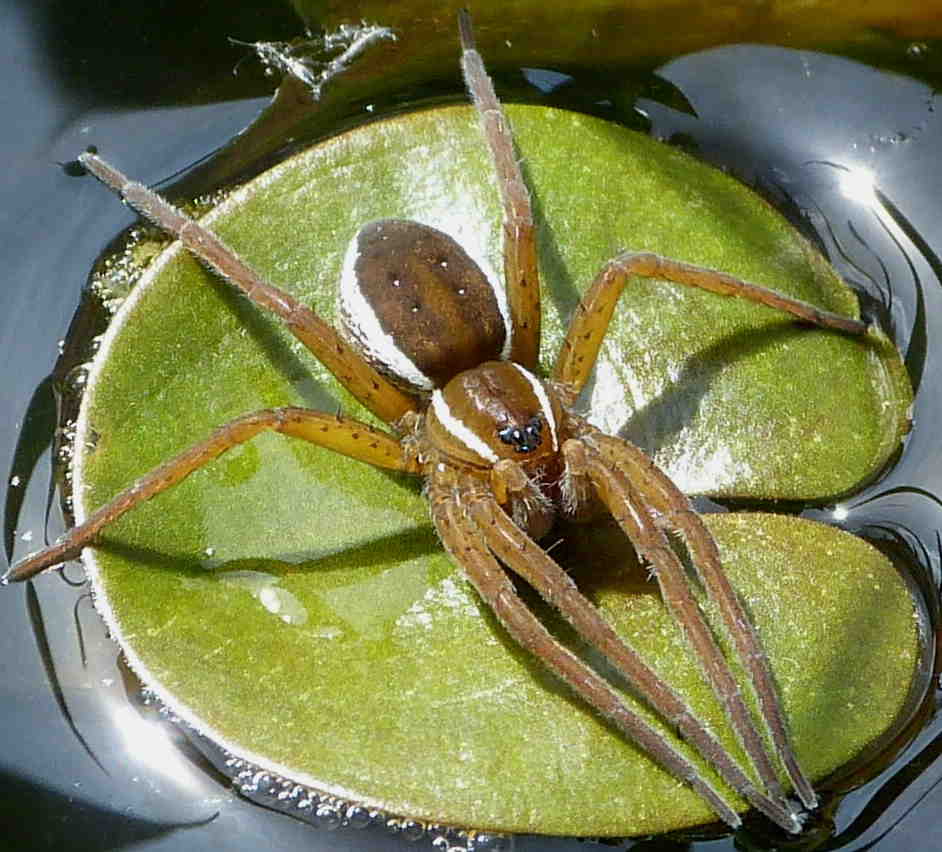The Fen Raft Spider is to become only the 6th spider species in the world to have its full genome sequenced. To celebrate its 25th anniversary in 2018, the Wellcome Trust's Sanger Institute are sequencing 25 new genomes of UK species. Championed by the Nottingham Spider Lab and supported by the British Arachnological Society, the Fen Raft Spider was one of five species chosen by thousands of school children and members of the public around the globe, who participated in the 25 Genomes Project online vote. Huge thanks to all who voted for this ground-breaking work that will help to underpin the future conservation of this internationally threatened species.
Posted December 2017
Great new video clips from Neil Philips shows fen raft spider males competing over courtship of a female with an egg sac - who is definitely not interested! Watch it on YouTube.
Posted October 2015
'Love the Broads' announces funding to help with new translocations in Broadland over the next four years.
Posted October 2015
Summer 2015 sees big expansion in range of new populations. Click here to read more.
Posted October 2015
Fen raft poem by Caroline Gill is overall winner in the prestigious 2014 ZSL poetry competition. Read Caroline's poem here.
Posted May 2015
Just published - On the margins. The fen raft spiders of Redgrave & Lopham Fen by Sheila Tilmouth and Helen Smith with foreword by Mark Cocker. The latest in the Langford Press Wildlife and People series, this book brings together artist Sheila Timouth's beautiful and dramatic images of the spiders at Redgrave & Lopham Fen with text by Helen Smith describing the spiders' lives and the long struggle to ensure their future. Click here for more information.
Posted October 2014
Bumper breeding season for East Anglia's new fen raft spider populations
Summer 2014 saw record breeding numbers in all three of the fen raft spider populations established in the Norfolk and Suffolk Broads since 2010. On one 70m stretch of ditch on the lower reaches of the river Waveney over 400 nurseries were recorded between mid-June and the end of September. On the mid-Yare marshes, where saline flooding the December storm surge threatened the new population, recovery during the summer was remarkable, with substantial numbers of nurseries recorded within and beyond the introduction sites. Marked expansion in range of the spiders at all of the new sites is a further indication of their successful establishment.
Posted October 2014
Another new fen raft spider population for the Norfolk Broads
Following the successful establishment of the new populations on grazing marshes of the rivers Waveney and Yare in Broadland, fen raft spiders were translocation to another new site in 2014 - this time on the river Thurne marshes, taking the spiders into the heart of the Norfolk Broads.
Posted October 2014
December 2013 storm surge floods release site
The third fen raft spider population to be established by translocation in 2012/, on the River Yare grazing marshes, started to increase rapidly in 2013. But in early December the biggest storm surge on the east coast since 1953 breached the river bank protecting the site, flooding it with salt water. Although the heavy winter rains that followed rapidly flushed out the salt, the Water Soldier Stratiotes aloides in the ditches was badly affected. The floating rosettes of Water Soldier carpeted the ditches and provided ideal habitat for the spiders - this loss is a set-back for the new population. However, spiders are still present at the site and their recovery will be closely monitored.
Posted June 2014
Three new fen raft spider populations established in Broadland
By the end of 2013 three new populations of fen raft spiders had been established by translocation to Broadland in East Anglia, doubling the number of sites for this species in Britain. The spiders used to establish the populations came from both of the two remaining populations of this species in the wild in England. Those from the very small East Anglian population were introduced as tiny 3-month old spiderlings; survival rates of well over 90% were achieved by rearing them in captivity over this period. Spiders from the much larger population in East Sussex were introduced as mature females with nurseries containing upwards of 500 five-day old spiderlings.
During the summer of 2013, the first population, established on grazing marshes on the lower reaches of the River Waveney in 2010 and 2011, produced well in excess of 150 nurseries.
Posted January 2014
